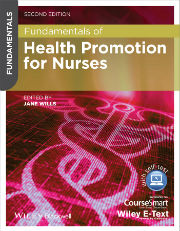
Fundamentals of Health Promotion for Nurses
Second Edition
Edited by Jane Wills

Short Answer Questions
Chapter 7: Sexual health
1. How would you define sexual health?
The World Health Organization defines sexual health as a "A state of physical, emotional, mental and social well being related to sexuality; it is not merely the absence of disease, dysfunction or infirmity."
2. Why might a patient's sexual health be a matter of concern?
A person's illness or disability may well have an impact on their sexual health and/or sexuality and that might be a concern to them but difficult to articulate. Some diseases such as HIV can cause multisystem problems that are often unrecognized.
3. What are the main priorities in sexual health strategy?
- Unintended pregnancies
- Numbers of abortions
- Transmissions of sexual transmitted infections (STIs)
- New HIV diagnoses.
4. What might account for the rise in diagnoses of sexually transmitted infections (STI)?
- Increased risk taking
- An increase in people seeking early diagnosis and treatment for infections
- Increased cases identified through screening such as the national chlamydia screening programme
- Increased use of sensitive tests
5. Which population groups are most at risk from HIV?
Half of those diagnosed in 2011 (48%, 3000) probably acquired their infection through sex between men and 47% (2890) through heterosexual contact. The overall decline in new diagnoses is largely due to fewer reported cases among heterosexuals who probably acquired their infection abroad.
6. Which is the most common STI?
Chlamydia is the most common STI with sexually active young people most at risk. It often has no symptoms but can lead to pelvic inflammatory disease, ectopic pregnancy or tubal damage. There has been an opportunistic national screening programme for under-25-year-olds since 2003.
7. What is Point of Care testing (POCT)?
Conventional HIV testing requires the submission of a blood sample and a follow up return visit one or two weeks later to get the result, meaning that some people will not return for test results. Rapid HIV tests use whole blood or saliva tests for HIV antibodies, indicating HIV infection. Known as Point of Care (PoCT) or near-patient tests, results are available in minutes allaying some patient anxiety.
8. Who should have an HIV test?
HIV testing is now recommended for all pregnant women, TB patients, all new GP registrants, all medical admissions in areas of high prevalence and to patients from high risk groups.